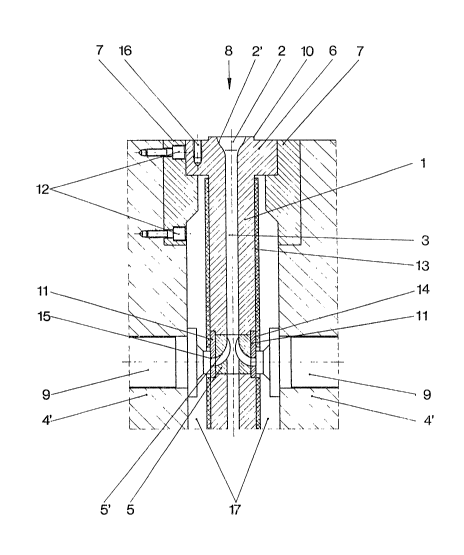Note: Claims are shown in the official language in which they were submitted.
The embodiments of the invention in which an exclusive
property or privilege is claimed are defined as follows:
1. In an apparatus for the manufacture of plastic parts
from thermoplastic, thermoset and/or elastomer material by
injection molding or reaction injection molding, said apparatus
having a multi-station locking unit of horizontal or vertical
configuration adapted to hold a number of molds, an injection
unit associated therewith for the simultaneous injection of the
molds, two outer mold clamping plates, one of which is mounted
on guide elements and movable thereon in the locking direction,
a center mold-receiving part movably mounted on guide elements
between the two mold clamping plates and having a heatable melt
conduction system with sprue nozzles and one half of a mold
attached to each of its sides, the center mold-receiving part
being adapted as a mold clamping plate sectioned lengthwise
relative to the locking direction for receiving larger halves
of a mold, the two parts of the plate being kept together by a
high-speed clamping device and having a melt conduction system
mounted between the parts, and separate driving cylinders
attached to the center mold clamping plate, the improvement
comprising:
said melt conduction system having at least one melt
conduction rail, each said at least one melt conduction rail
being rigidly clamped at its face side lengthwise relative to
the direction of flow between the sectioned mold clamping plate.
-7-
2. The apparatus according to claim 1, comprising a
plurality of separate melt conduction rails.
3. The apparatus according to claim 1, wherein each of
said at least one melt conduction rails is designed as one
piece.
4. The apparatus according to claim 1, wherein each of
said at least one melt conduction rails has a central melt
conduit.
5. The apparatus according to claim 1, wherein counter
opposed melt distributors are mounted in said at least one melt
conduction rail.
6. The apparatus according to claim 5, wherein at least
two pairs of melt distributors are mounted.
7. The apparatus according to claim 1, wherein each of
said at least one melt conduction rails has an outer flange on
each of its two face sides, each of said flanges being
associated with a guide coupling supported in the sectioned
mold clamping plate.
8. The apparatus according to claim 7, wherein said guide
couplings extend across the width of the sectioned mold
clamping plate and are connected thereto.
-8-
9, The apparatus according to claim 7, wherein the outer
boundaries of said flanges are approximately aligned with the
inner boundaries of the sectioned mold clamping plate.
10. The apparatus according to claim 9, which further
comprises a median centering collar arranged on the face side
of the melt conduction rail for receiving the nozzle system.
11. The apparatus according to claim 4, wherein said melt
conduit of the said at least one melt conduction rail has a
widened melt inlet.
12. The apparatus according to claim 11, wherein said melt
inlet has rounded side walls.
13. The apparatus according to clam 1, which further
comprises threaded bores arranged on the face side of the melt
conduction rail for connecting the latter with the nozzle
system.
14. The apparatus according to claim 1, wherein each said
at least one melt conduction rail is rigidly connectable with
the nozzle system on its face side.
15. The apparatus according to claim 1, wherein said
nozzle system is fastened and locked on the sectioned mold
clamping plate via a high-speed clamping device.
-9-
16. The apparatus according to claim 1, wherein a band
heater is mounted on the outer surfaces of each said at least
one melt conduction rail.
17. The apparatus according to claim 16, wherein each band
heater may be separately heated and adjusted to the appropriate
operating temperature.
18. The apparatus according to claim 5, wherein a curved,
in the direction of flow, melt feeding conduit leading to the
sprue nozzles is arranged in each melt distributor.
19. The apparatus according to claim 18, wherein a
pressure plate is arranged on the outer side of each melt
distributor.
20. The apparatus according to claim 19, wherein said
pressure plate extends flush with the outer side of the at
least one melt conduction rail.
21. The apparatus according to claim 20, wherein said
pressure plate has a bore with a diameter matching the end
diameter of said curved melt feeding conduit of the melt
distributor.
22. The apparatus according to claim 5, wherein the
contact surfaces of the sprue nozzles can be closely pressed
against the pressure plates of the melt distributors.
-10-
23. The apparatus according to claim 16, wherein said band
heater is interrupted in the neighborhood of the contact
surfaces of the nozzles.
24. The apparatus according to claim 22, wherein the outer
side of the pressure plate is slidably guided on the contact
surface of the nozzle.
25. The apparatus according to claim 1, wherein guides are
arranged on the inner side walls of the sectioned mold clamping
plate, in which the melt conduction rail is height adjustable.
26. The apparatus according to claim 1, wherein a separate
screw unit is associated with each melt conduction rail.
-11-
